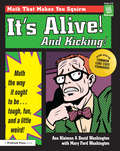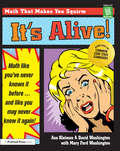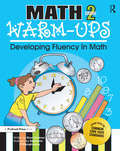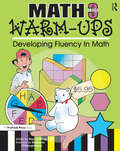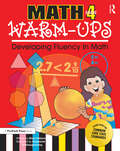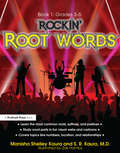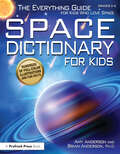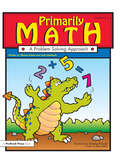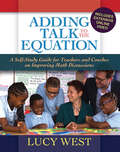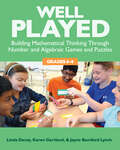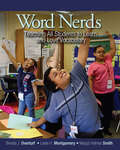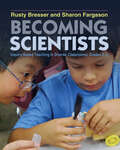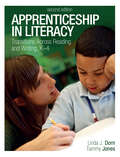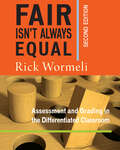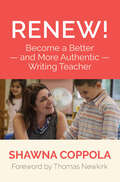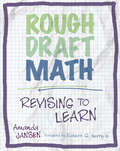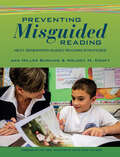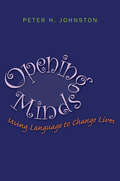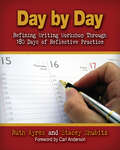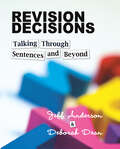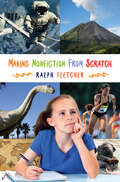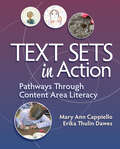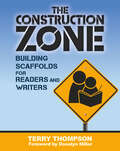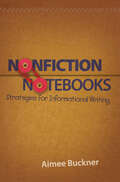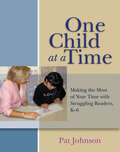- Table View
- List View
It's Alive! And Kicking!: Math the Way It Ought to Be - Tough, Fun, and a Little Weird! (Grades 4-8) (Its Alive! Ser.)
by Asa Kleiman David Washington Mary Ford WashingtonThe authors, junior high students and best friends David and Asa, along with best-selling author Marya Washington Tyler, took the kind of gooey, slimy, disgusting science facts that students love and turned them into hilarious math problems. Your students will enjoy trying to determine what percent of the refrigerators in the U.S. contain moldy food. When's the last time you had your students figure the weight of cow manure produced in the U.S.?How many 8-ounce coffee mugs will an average person's sweat fill? What is the number of saliva droplets expelled in one class period?Your students won't mind math when they get to figure the cost of a meal at the Aftermath Restaurant, with foods like Deep Fried Lint, Pseudo-Chicken Parts, Wax Fruit Bowl, and Hot Sludge Sundae. Even the answer key is hilarious.These and other intriguing problems await your students in this book designed to teach children to translate statements and questions into mathematical equations. All the problems are based on known scientific facts. For even more exciting and strange math problems, see the original It's Alive!Grades 4-8
It's Alive!: Math Like You've Never Known It Before (Grades 4-8) (Its Alive! Ser.)
by Asa Kleiman David Washington Mary Ford WashingtonThe authors, junior high students and best friends David and Asa, along with best-selling author Marya Washington Tyler, took the kind of gooey, slimy, disgusting science facts that students love and turned them into hilarious math problems. Problems in It's Alive! include:When's the last time you had your students calculate their chances of being eaten by a crocodile?The percent of seats at Yankee Stadium that do not have gum stuck to them?The number of skin scales they lost in the last 20 minutes?The number of flushes it would take to overflow their city's wastewater treatment tank?Or how many gigabytes their brain can hold?These and other intriguing problems await your students in this book designed to teach children to translate statements and questions into mathematical equations. All the problems are based on known scientific facts.This is math. This is real. This is alive! Included is a comprehensive answer key, reproducible blackline masters, and hilarious illustrations. This is math the way it ought to be—tough, fun, and...a little weird. For even more exciting and strange math problems, see the follow-up It's Alive! And Kicking!Grades 4-8
Math Warm-Ups: Developing Fluency in Math (Grade 2) (Math Warm-ups Ser.)
by Sheri DisbrowThese success-proven exercises provide daily practice in various areas of math. There are 10 problems per page that reinforce and facilitate conceptual understanding in number sense, math reasoning, computation, time, money, measurement, geometry, probability, graphing, fractions, and decimals. The exercises systematically provide students opportunities to get practice in the most important math objectives each week and provide the teacher with immediate, easy-to-administer feedback on students' mastery.This workbook can be used as a warm-up, homework, or as a diagnostic tool for the teacher, parent, or administrator. The individual pages can be used to diagnose weak areas and provide opportunities to facilitate the students' full understanding of concepts. Students are challenged and consistently exposed to a variety of concepts in all objective areas. Each book spirals in level of difficulty and continues to encourage students to think about math in real-life situations.For math proficiency activities at more advanced levels, see Math Warm-Ups Grade 3 and Math Warm-Ups Grade 4.This series meets NCTM standards and builds test-taking proficiency.Grade 2
Math Warm-Ups: Developing Fluency in Math (Grade 3) (Math Warm-ups Ser.)
by Sheri DisbrowThese success-proven exercises provide daily practice in various areas of math. There are 10 problems per page that reinforce and facilitate conceptual understanding in number sense, math reasoning, computation, time, money, measurement, geometry, probability, graphing, fractions, and decimals. The exercises systematically provide students opportunities to get practice in the most important math objectives each week and provide the teacher with immediate, easy-to-administer feedback on students' mastery.This workbook can be used as a warm-up, homework, or as a diagnostic tool for the teacher, parent, or administrator. The individual pages can be used to diagnose weak areas and provide opportunities to facilitate the students' full understanding of concepts. Students are challenged and consistently exposed to a variety of concepts in all objective areas. Each book spirals in level of difficulty and continues to encourage students to think about math in real-life situations.For math proficiency activities at alternative levels, see Math Warm-Ups Grade 2 and Math Warm-Ups Grade 4.This series meets NCTM standards and builds test-taking proficiency.Grade 3
Math Warm-Ups: Developing Fluency in Math (Grade 4) (Math Warm-ups Ser.)
by Sheri DisbrowThese success-proven exercises provide daily practice in various areas of math. There are 10 problems per page that reinforce and facilitate conceptual understanding in number sense, math reasoning, computation, time, money, measurement, geometry, probability, graphing, fractions, and decimals. The exercises systematically provide students opportunities to get practice in the most important math objectives each week and provide the teacher with immediate, easy-to-administer feedback on students' mastery.This workbook can be used as a warm-up, homework, or as a diagnostic tool for the teacher, parent, or administrator. The individual pages can be used to diagnose weak areas and provide opportunities to facilitate the students' full understanding of concepts. Students are challenged and consistently exposed to a variety of concepts in all objective areas. Each book spirals in level of difficulty and continues to encourage students to think about math in real-life situations.For math proficiency activities at lower levels, see Math Warm-Ups Grade 2 and Math Warm-Ups Grade 3.This series meets NCTM standards and builds test-taking proficiency.Grade 4
Rockin' Root Words: Book 1, Grades 3-5 (Rockin' Root Words Ser. #1)
by Manisha Shelley Kaura S.R. KauraIf your students like Red Hot Root Words, they are going to love Rockin' Root Words, an exciting twist on vocabulary development! In these comprehensive books, students will enjoy learning the roots, suffixes, and prefixes of more than 500 common vocabulary, words presented in an easy-to-follow style that utilizes visual learning and word maps to enhance student comprehension and memory.By teaching students word parts using word webs, graphic organizers, and cartoons, teachers can ensure that every student in their classroom understands the basics of vocabulary development. Book 1 is focused on vocabulary for grades 3-5 and covers a variety of topics, including numbers, colors, family and relationships, location and distance, and scientific vocabulary.Grades 3-5
Space Dictionary for Kids: The Everything Guide for Kids Who Love Space
by Brian Anderson Amy AndersonPacked with hundreds of illustrated definitions about astronomy and space, Space Dictionary for Kids is certain to spark any kid's enthusiasm for the solar system and galaxy. Explore cosmology, stars and galaxies, the solar system, space exploration, and exoplanets and astrobiology. Hop on an astronomy timeline to learn the story of how primitive ancient beliefs evolved over centuries to become a high-technology science. Crack up over the humorous sidebars that expand on the topic of space with examples, explanations, diagrams, quizzes, and even short activities to enhance understanding. Use the references and further reading recommendations at the end to help find more information about astronomy, perfect for assignments or those just wanting to know more about the coolest topic in the galaxy! Divided into sections for quick access to the easy-to-understand definitions and amazing full-color illustrations, Space Dictionary for Kids is a must-have for any kid's home library!Grades 3-6NSTA Recommends
Primarily Math: A Problem Solving Approach (Grades 2-4)
by Sharon Eckert Judy LeimbachIt is important that schools emphasize a problem-solving approach to mathematics beginning in the early years and continuing through high school. Students should learn to value the process of solving problems, as well as getting the correct solutions. The strategies in this book will help students reason, develop their problem-solving strategies, grow in their ability to communicate mathematically, and develop confidence in their mathematical abilities.Five different problem-solving strategies are carefully taught using teacher-directed interactive introductory lessons. A series of practice problems follow the introductory lessons for each strategy. The strategies include: using a manipulative or acting out a problem, drawing a picture or diagram, extending a repeating pattern,making a table or list, and choosing relevant information. Each strategy is first introduced through several carefully presented problems that include introductory group lessons and instructional notes for the teachers. Additionally, the last section of the book presents a variety of problems that give students the opportunity to apply the problem-solving strategies they have learned. This is the perfect supplement to any primary math program, as well as an excellent resource for a math center. All problems are delightfully illustrated and reproducible.Grades 2-4
Adding Talk To The Equation: A Self-Study Guide for Teachers and Coaches on Improving Math Discussions
by Lucy WestFor more than 20 years, Lucy West has been studying mathematical classroom discourse. She believes that teachers need to understand what their students are thinking as they grapple with rich mathematical tasks and that the best way to do so is through talking and listening. In this video-rich edition of Adding Talk to the Equation: Discussions and Discovery in Mathematics, she invites teachers into real-life classrooms where all students stay in the game, stay motivated about learning, and ultimately deepen their understanding. Designed for math teachers and coaches in grades 18, this self-study guide showcases elementary and middle school classrooms where teachers inspire even the most reluctant students to share their ideas. Through the stories of skilled teachers, West offers play-by-play commentary as they get more comfortable with new talk moves and learn to tune in and respond to students' math conversations. Although these discussions occur in math class, the strategies can be used to create a respectful, productive environment for any subject area. This video-based resource examines the importance of creating a safe learning environment; the value of thinking, reasoning, and questioning; the role of active, accountable listening; and the necessity of giving all students a you can do this message. West also emphasizes that slowing down, even in the face of time constraints, is crucial for creating a classroom where all students feel they have something to contribute. This guide includes transcripts of the case studies, with insightful commentary from West that gives you a window into her thinking and the complexities of the work she is doing with teachers, as well as her reflections on missed opportunities.
Well Played, Grades 6-8: Building Mathematical Thinking Through Number and Algebraic Games and Puzzles
by Linda Dacey Karen Gartland Jayne Bamford LynchStudents love math games and puzzles, but how much are they really learning from the experience? Too often, math games are thought of as just a fun activity or enrichment opportunity. Well Played, Grades 6-8: Building Mathematical Thinking Through Number and Algebraic Games and Puzzles shows you how to make games and puzzles an integral learning component that provides teachers with unique access to student thinking. This third book in the series helps you engage students in grades 6-8 in discussions of mathematical ideas and deepen their conceptual understanding. It also helps you develop students' fluency with number systems; ratio and proportional relationships; expressions and equations, statistics and probability; and patterns, graphs, and functions. The twenty-five games and puzzles in Well Played, Grades 6-8 which have all been field-tested in diverse classrooms, contain: Explanations of the mathematical importance of each game or puzzle and how it supports student learning. Variations for each game or puzzle to address a range of learning levels and styles Classroom vignettes that model how best to introduce the featured game or puzzle. The book also includes a separate chapter with suggestions for how to effectively manage games and puzzles in diverse classrooms; game boards, game cards, and puzzles; assessment ideas; and suggestions for online games, puzzles, and apps. Well Played, Grades 6-8 will help you tap the power of games and puzzles to engage students in sustained and productive mathematical thinking.
Word Nerds: Teaching All Students to Learn and Love Vocabulary
by Leslie Montgomery Brenda L. Overturf Margot Holmes SmithWord mastery comes from intimate knowledge of language. In Word Nerds : Teaching All Students to Learn and Love Vocabulary, authors Leslie Montgomery and Margot Holmes Smith take you inside classrooms where they implement creative, flexible vocabulary instruction that improves their students' word knowledge and confidence. With support from literacy specialist Brenda Overturf, the authors developed a five-part plan to teach all students to learn vocabulary: Introducing new words in contextAdding related synonyms and antonymsEngaging in several days of active learningCelebrating new wordsAssessing vocabulary developmentThis easy-to-read reference explains how to plan, teach, and assess based on the latest research in vocabulary instruction and learning. After incorporating the authors' plan, you can be a Word Nerd too!
Becoming Scientists: Inquiry-Based Teaching in Diverse Classrooms, Grades 3-5
by Rusty Bresser Sharon FargasonMost important to being a good science teacher is holding the expectation that all students can be scientists and think critically. Providing a thinking curriculum is especially important for those children in diverse classrooms who have been underserved by our educational system. -; Becoming Scientists Good science starts with a question, perhaps from the teacher at the start of a science unit or from the children as they wonder what makes a toy car move, how food decomposes, or why leaves change color. Using inquiry science, children discover answers to their questions in the same way that scientists do-;they design experiments, make predictions, observe and describe, offer and test explanations, and share their conjectures with others. In essence, they construct their own understanding of how the world works through experimentation, reflection, and discussion. Look into real classrooms where teachers practice inquiry science and engage students in the science and engineering practices outlined in the Next Generation Science Standards. Rusty Bresser and Sharon Fargason show teachers how to do the following: Build on students' varied experiences, background knowledge, and readiness Respond to the needs of students with varying levels of English language proficiency Manage a diverse classroom during inquiry science exploration Facilitate science discussions Deepen their own science content knowledgeAs the authors state, Inquiry science has little to do with textbooks and lectures and everything to do with our inherent need as a species to learn about and reflect on the world around us. Join your students on a journey of discovery as you explore your world via inquiry.
Apprenticeship in Literacy: Transitions Across Reading and Writing, K-4
by Tammy Jones Linda DornGrounded in social and cognitive learning theories, the second edition of Apprenticeship in Literacy: Transitions Across Reading and Writing, K-4 still details the seven principles of apprenticeship learning and helps K -4 teachers implement and assess guided reading, assisted writing, literature discussion groups, word study lessons, and literacy centers across an integrated curriculum. The new edition also features the following: Updated research emphasizing the importance of early reading as a road map for successInformation on how behaviors, from emergent to fluent, align to the Common Core State StandardsDozens of new classroom examples-;students' work, photographs, transcripts, teacher-student conferences, and reproducible resourcesLanguage prompts that promote self-regulated learnersSchedules for implementing a workshop framework in whole-group, small-group, and one-to-one settingsSuggestions for incorporating information texts into a balanced literacy programStronger emphasis on the importance of the writing processAdditional ideas on establishing routines and organizing the classroomThe theme of apprenticeship in literacy resonates throughout the book: children learn from teachers and teachers learn from one another as they promote children's transfer of knowledge across multiple contexts. The final chapter provides real-world examples of teachers working together to ensure that all children become literate.Since its original publication in 1998, Apprenticeship in Literacy has become a teacher favorite, covering all aspects of a balanced literacy program in an integrated manner and showing how all components are differentiated to address the needs of diverse learners. An apprenticeship approach to literacy emphasizes the role of the teacher in providing demonstrations, engaging children, monitoring their understanding, providing timely support, and ultimately withdrawing that support as the child gains independence.
Fair Isn't Always Equal: Assessment & Grading in the Differentiated Classroom
by Rick WormeliDifferentiated instruction is a nice idea, but what happens when it comes to assessing and grading students? How can you capture student progress, growth, and soft skill development and still provide an equitable grading environment?' An internationally recognized expert on grading practices, author Rick Wormeli revisits these questions in this thoroughly updated second edition of Fair Isn' t Always Equal: Assessment and Grading in the Differentiated Classroom.' Wormeli reflects on current grading and assessment practices and how they can exist with high-stakes, accountable classrooms. Important and sometimes controversial issues are tackled constructively in this book, incorporating modern pedagogy and addressing the challenges of teaching diverse groups of students across all learning levels.' Middle- and high-school educators will easily recognize' gray areas of grading and how important it is to have a shared school vision. In this second edition, new sections address sports eligibility, honor roll, descriptive feedback techniques, and gifted/talented students.' Previous chapters on test questions, redos/retakes, grading scales, and grading effort and behavior have been revised extensively. This important book clearly explains the principles behind best grading practices so that you' re ready for all grading questions or scenarios that you may encounter in your classrooms and schools.
Renew!: Become a Better and More Authentic Writing Teacher
by Shawna CoppolaWhen was the last time you shook up your writing instruction? In Renew!: Become a Better and More Authentic Writing Teacher, author Shawna Coppola builds on the premise that our students are ever-changing, and so is our collective knowledge base. Instructional strategies that have worked in the past may need to evolve accordingly. Coppola guides K-8 writing teachers with a three-part framework for Rethinking, Revising, and Renewing their approach'sand finding new energy along the way. Using the framework, Renew! examines the most pervasive educational practices in writing instruction and poses questions that guide teachers to revise those practices to ensure they are effective for all students. Coppola believes the work is challenging, yet critical, referencing R. Buckminster Fuller's Knowledge Doubling Curve: According to Fuller's paradigm, the amount of time it takes for us to increase our collective knowledge base by 100 percent will continue to shrink the older we get. If this is true'sor even close to being true'show can we, as educators, ever feel satisfied with teaching our students the same concepts, using the same methodologies and practices, that we have in the past? The book offers a road map for renewing key aspects of our practice, including: How we teach the writing process: Over time and frequent usage, some of our favorite teaching strategies can become rigid. Coppola gives a candid account of how her enthusiasm for the writing process as an undergraduate led her to teach writing for years as a set of pre-determined steps. Now she teaches that there are many variations of the writing process, and many twists and turns along the path. One foundational strategy used is opening up her own process as a writer'sand her writer's notebook'sto students and encouraging them to think and talk about their process with classmates. What we mean by Writing: Coppola argues that drawing isn't an accompaniment to writing; it is writing. Its another form of composition through which students can tell stories, convey ideas, and engage readers. The book is full of visual compositions by students as well as Shawna's wonderfully simple and evocative sketches from her writer's notebook. The tools we use to teach writing: The most ubiquitous tools used to teach writing'sfrom anchor charts to graphic organizers to sentence starters etc.'stend to be teacher-centric rather than student-centric. Renew! invites students into the process of constructing tools that are meaningful and helpful to them. The book includes a range of examples of tools built collaboratively with students. How we assess and evaluate student writing: Coppola draws a distinction between assessment'swhich should be an interactive conversation with students'sand evaluation, which is about judging and categorizing what students know and can do. Renew! offers a range of examples and resources that illustrate effective feedback for student writers, including online videos of teacher-student and peer-to-peer conferences. Renew! also offers ideas for how teachers can nurture their own writing lives and thus reinvigorate their instructional practice. Through rethinking, revising, and renewing their practice, teachers can not only strengthen students' skills as writers, but also nurture students to become critical thinkers, problem solvers, and risk takers in the classroom and in our rapidly-changing world.
Rough Draft Math: Revising to Learn
by Amanda JansenTalking and writing about unfinished ideas is vital to learning mathematics, but most students only speak up when they think they have the right answer - especially middle school and high school students. Amanda Jansen and her collaborating teachers have developed a breakthrough approach to address this challenge. Rough Draft Math: Revising to Learn, Jansen shares the power of infusing math class with the spirit of revision so that students feel comfortable thinking aloud as they problem-solve rather than talking only to perform right answers. Creating a Community of Learners: As part of the rough draft framework, a class of students becomes an equitable and inclusive community of thinkers, one where students feel safe to engage in discourse while developing mathematical competency and confidence Practical Application of Innovative Ideas: This book includes specific teaching techniques and a range of classroom vignettes showing rough draft math in action within a student-centered teaching approach. Children can develop solutions at their own pace and share thought processes behind their conclusions Classroom Tested: Jansen has developed the concept of rough draft math in collaboration with a diverse group of dynamic and reflective teachers. Rough Draft Math' provides a blueprint for educators to allow free-thinking discussion while maintaining the mathematical learning goalsRough Draft Math, Jansen shows how to create an energetic classroom culture where students readily participate and share their evolving understanding while engaging in math talk, collaborative problem solving, and ongoing revision of ideas. '
Preventing Misguided Reading: Next Generation Guided Reading Strategies
by Jan Burkins Melody M. CroftWith over 50 years of collective reading experience, authors Jan Burkins and Melody Croft bring their expertise to Preventing Misguided Reading: Next Generation Guided Reading Strategies . The authors present personal clarifications, adaptations, and supports that have helped them work through the tricky parts as they guide readers in the classroom. Inside, each of the six chapters clarifies a misunderstanding about guided reading instruction in the following areas: Teacher's Role and Gradual Release of Responsibility Instructional Reading Level Text Gradients Balanced Instruction Integrated Processing Assessment With 27 strategies, Burkins and Croft will help you reframe your way of thinking about teaching reading and act on "revisioning" strategically.
Opening Minds: Using Language to Change Lives
by Peter JohnstonIntroducing a spelling test to a student by saying, 'Let' s see how many words you know,' is different from saying, 'Let's see how many words you know already.' It is only one word, but the already suggests that any words the child knows are ahead of expectation and, most important, that there is nothing permanent about what is known and not known. Peter Johnston Grounded in research, Opening Minds: Using Language to Change Livesshows how words can shape students' learning, their sense of self, and their social, emotional and moral development. Make no mistake: words have the power to open minds – or close them. Following up his groundbreaking book, Choice Words, author Peter Johnston continues to demonstrate how the things teachers say (and don't say) have surprising consequences for the literate lives of students. In this new book, Johnston shows how the words teachers choose can affect the worlds students inhabit in the classroom. He explains how to engage children with more productive talk and how to create classrooms that support students' intellectual development, as well as their development as human beings.
Day by Day: Refining Writing Workshop Through 180 Days of Reflective Practice
by Stacey Shubitz Ruth AyresHave you ever wanted your own personal writing coach to help improve your teaching of writing? How about two personal writing coaches? In Day by Day, Stacey Shubitz and Ruth Ayres, creators of the popular blog Two Writing Teachers, guide you through the trials and tribulations of a whole year of writing workshop. ' Day by Day is organized around six fundamental components of writing workshoproutines, mini-lessons, choice, mentors, conferring, and assessment. Each component is broken down into ten-day sections. Each section includes a detailed discussion, a challenge that teachers can apply immediately,' and questions to help teachers assess the process to see what went right, what went wrong, and, most importantly, why.' Ruth and Stacey also provide daily encouragement, support, practical strategies, tips, advice, and everything you need to run an effective writing workshop that meets the needs of all the different writers in your classroom.
Revision Decisions: Talking Through Sentences and Beyond
by Jeff Anderson Deborah DeanRevision is often a confusing and difficult process for students, but it's also the most important part of the writing process. If students leave our classrooms not knowing how to move a piece of writing forward, we've failed them. Revision Decisions: Talking Through Sentences and Beyond will help teachers develop the skills students need in an ever-evolving writing, language, and reading world. Jeff Anderson and Deborah Dean have written a book that engages writers in the tinkering, playing, and thinking that are essential to clarify and elevate writing. Focusing on sentences, the authors use mentor texts to show the myriad possibilities that exist for revision. Essential to their process is the concept of classroom talk. Readers will be shown how revision lessons can be discussed in a generative way, and how each student can benefit from talking through the revision process as a group. Revision Decisions focuses on developing both the writing and the writer. The easy-to-follow lessons make clear and accessible the rigorous thinking and the challenging process of making writing work. Narratives, setup lessons, templates, and details about how to move students toward independence round out this essential book. Additionally, the authors weave the language, reading, and writing goals of the Common Core and other standards into an integrated and connected practice. The noted language arts teacher James Britton once said that good writing floats on a sea of talk. Revision Decisions supports those genuine conversations we naturally have as readers and writers, leading the way to the essential goal of making meaning.
Making Nonfiction from Scratch
by Ralph FletcherDo you have students whose nonfiction writing is formulaic, devoid of energy and voice? In Making Nonfiction from Scratch bestselling PD and children's book author Ralph Fletcher offers a candid critique of how nonfiction writing is often taught in schools and gives teachers the inspiration and strategies they need to help their students write authentic nonfiction. Skilled nonfiction writers draw on strategies, techniques, and craft found in other genres: poetry, comedy, even mystery. Without those elements, nonfiction would be dry and dull. Making Nonfiction from Scratch helps bring all of those aspects together and shows how each genre can enrich nonfiction writing. Ralph emphasizes the power of choice, mentor texts, and nonfiction read-alouds in making nonfiction an everyday part of classrooms. Classroom Connection- sections throughout the book suggest immediate, practical strategies for putting the ideas in the book to use. Two case studies and a chapter on the dos and don'ts of nonfiction writing instruction round out this short, practical book. Any informational writing should be insightful, accurate, and well organized - but it doesn't have to be boring. Ralph invites you to make your classroom a place where students can create delicious nonfiction full of passion, voice, and insight.
Text Sets in Action: Pathways Through Content Area Literacy
by Mary Ann Cappiello Erika Thulin DawesFinding ways to organize your classroom instruction for knowledge building and literacy learning can be challenging. How can you incorporate more nonfiction and informational text in your content area curriculum while expanding and deepening representation with diverse texts? What can motivate student learning while providing equity and access for different learning styles and needs? Text sets are the answer!In Text Sets in Action: Pathways Through Content Area Literacy, authors Erika Thulin Dawes and Mary Ann Cappiello demonstrate how text sets offer students the opportunity to build critical thinking skills and informational literacy while generating interest and engagement across the content areas. Put your students in the center of the meaning-making in your classroom with multimodal multi-genre text sets in action. In Text Sets in Action, the authors: Model how text sets build foundational skills and metacognitive strategies as students experience a carefully scaffolded and sequenced exploration of ideas, academic, and content vocabularyExplain how text sets encourage classroom discussion by having students ask questions about what they read, debate different perspectives, and relate the texts to their own personal experiences and the changes they would like to see in the worldShow how children's literature and multimodal, multi-genre texts can serve as mentor texts for student writing and inspire creativity and advocacyDemonstrate how to curate text sets that can introduce diverse and underrepresented voices into the classroom, fostering appreciation for different points of view and generate deeper critical thinkingProvide resources and suggestions for designing text sets a multimodal, multi-genre text set can include children's literature of all genres, as well as digital texts, YouTube videos, news articles, podcasts, and more Text Sets in Action will help you create a collection of text sets that can be added to or edited over the years to align with your lesson plan goals. Teachers who have adopted this approach saw greater student reading comprehension and critical thinking skills. By introducing a multitude of text, teachers will ignite a spirit of inquiry and engagement for lifelong learning.
Construction Zone: Building Scaffolds for Readers and Writers
by Terry ThompsonInstructional scaffolding is an essential part of teaching literacy. But what is scaffolding exactly? What does it look like in a classroom, and how can we improve the ways we use it? Despite its prominence in the repertoire of teaching strategies, scaffolding remains a vague concept for many teachers. ' In essence, scaffolding is the idea of supporting students as they build independence. In The Construction Zone: Building Scaffolding for Readers and Writers, Terry Thompson identifies four critical processes to deepen your understanding and improve your practice of instructional scaffolding: ·' ' ' ' ' ' ' ' Finding and maintaining a specific focus ·' ' ' ' ' ' ' ' Practicing flexibility in planning and delivering instruction ·' ' ' ' ' ' ' ' Giving constructive feedback in response to student efforts ·' ' ' ' ' ' ' ' Monitoring to ensure that students are working at optimal levels of responsibility Thompson' encourages teachers to enhance their use of the traditional gradual release process through five actionable steps: show, share, support, sustain, and survey, and in doing so provides procedures and techniques to help them establish and maintain strong scaffolds throughout the instructional day. The Construction Zone is written from the teacher's perspective and urges educators to fully embrace their role in the scaffolding process while staying mindful of the effect it has on students. ' Taking a student from dependence upon the teacher to independent learning is what teaching is all about, and instructional scaffolding is key to accomplishing this goal. Regardless of where you are in your understanding of instructional scaffolding, The Construction Zone will raise your level of awareness around your instructional practices and the ways you scaffold students to independence.' '
Nonfiction Notebooks: Strategies for Informational Writing
by Aimee BucknerIn my classroom, I have found that through the support of notebook work, students can grow their writing and strengthen their ideas. With strong ideas, they can write better first drafts. The work we do in notebooks before rushing into a draft gives us time to envision our work, to find mentor texts we love, and to study those texts. In doing so, we actually are doing a lot of the revision- on our vision- before we write the draft. -; Nonfiction Notebooks Aimee Buckner has introduced writer's notebooks to hundreds of classrooms through her popular book Notebook Know-How , thereby helping students everywhere learn to improve their overallwriting by focusing on essential prewriting strategies. Now, using the same format, Aimee explains how writer's notebooks can help students improve their nonfiction writing-;reports, articles, memoirs, essays, and so forth-;which has taken on even greater importance because of the emphasis the Common Core State Standards place on informative/explanatory writing. As Aimee explains, the prewriting work a student does is particularly important when writing informational pieces. Writer's notebooks help students capture their thoughts, develop ideas, explore mentor texts, refine a research strategy, and play with multiple outcomes-;all of which lead to stronger concepts and better first drafts. Greater emphasis on the front end of the writing process also saves time and energy at the revision and editing stages. From exploring topics to gathering information to assessment, Nonfiction Notebooks takes teachers step-by-step through the process of how best to use notebooks for informational writing. Helpful reproducible forms are included both in the book and as downloads online.
One Child at a Time: Making the Most of Your Time with Struggling Readers, K-6
by Pat JohnsonEvery elementary teacher deals with students who struggle as readers on a daily basis. Each struggling child is complex and each has a unique history as a learner. In One Child at a Time, experienced literacy specialist and consultant Pat Johnson provides a framework she has used in numerous K-6 classrooms to help teachers understand and assist individual children. The four-step process outlined in the book enables teachers to focus carefully on specific strategies and behaviors; analyze them with theoretical and practical lenses; design targeted instruction in keeping with current research on reading process; and then assess and refine the teaching in conferences with the child. The framework is by no means an easy answer to a difficult problem, but through its use teachers learn how the reading process works for proficient readers and how to support struggling readers as they construct their own reading process. The text is packed with examples of actual conferences with students, detailing how and when Pat and her colleagues intervene to instruct and assess. The examples of follow-up assessment and analysis of struggling readers over days and weeks provide an indispensable model for teachers. Pat shows how to use this framework successfully with a range of learners, including young children, English language learners, and students in the upper elementary grades who are stalled in their literacy progress. She builds upon her decades of work as a classroom teacher, literacy specialist, and consultant in schools with high poverty and diversity, to demonstrate how this framework can be useful in any setting.
